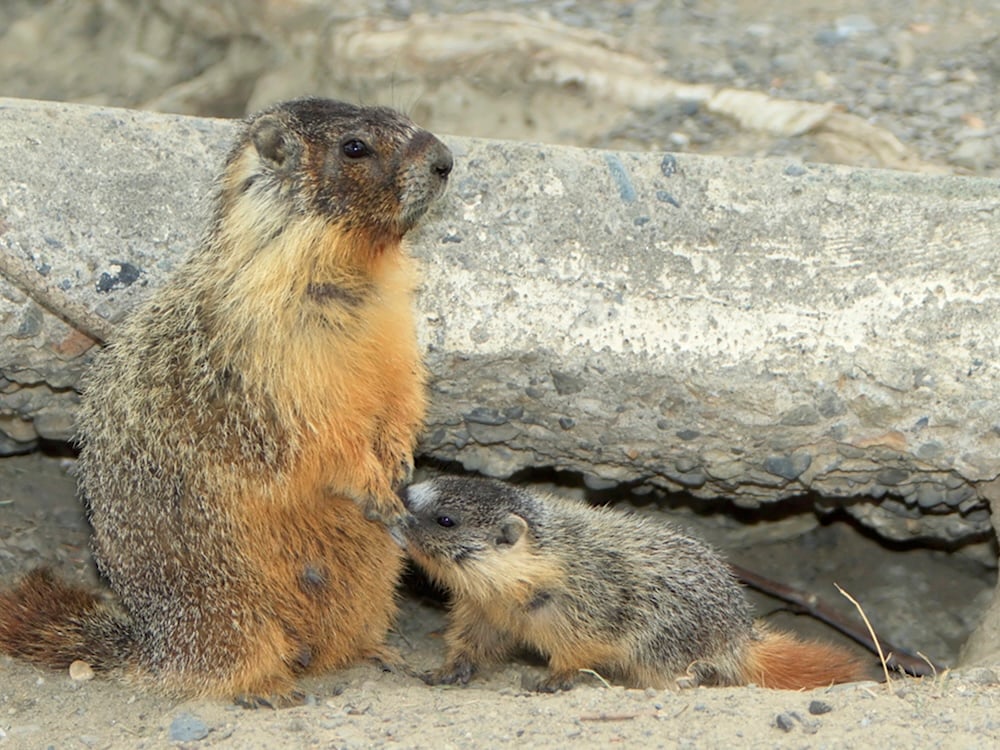Top Stories
Merritt Takes Action to Relocate Cemetery Marmots After Damage

The city of Merritt, located in British Columbia’s Nicola Valley, has initiated a plan to address a growing issue involving marmots in its cemetery. Once cherished as local mascots, these rodents have begun to damage gravesites, prompting city officials to allocate $10,000 for trapping and relocating them. This action follows unsuccessful attempts to deter the marmots with coyote urine.
The cemetery, which features both historic and contemporary sections, has become increasingly attractive to marmots. These animals prefer open spaces that provide clear sightlines for spotting predators. Unfortunately, their burrowing activities have compromised the stability of grave markers and other structures, raising concerns among families and staff alike.
During a visit in July, Mayor Mike Goetz observed dozens of marmots near the cemetery’s columbarium, describing the scene as a “stampede.” Reports from residents have suggested that marmots may even be robbing graves, with one staff member mentioning rumors of the rodents carrying bones. While these claims have not been substantiated, they highlight the growing frustration over the marmot population.
Despite some community members advocating for culling the rodents, Goetz emphasized the city’s commitment to humane treatment. “We’re not going to do anything nasty to the marmots,” he stated during a council meeting. Both the Vancouver Island marmots and yellow-bellied marmots are protected under the Species at Risk Act and the BC Wildlife Act, making culling not a viable option.
The city has opted for a different approach. According to a Merritt spokesperson, the municipality has no prior records of dealing with rodent issues in the cemetery until this year. The current situation marks a shift from viewing marmots as a lighthearted community symbol to addressing their impact on public spaces.
The planned trapping will be conducted by a local professional, although concerns remain regarding its long-term effectiveness. Cynthia Whyte, Merritt’s Chief Administrative Officer, noted that trapping may become a recurring necessity. “It’s unlikely we’ll get them all, so there will still be marmots breeding in the cemetery,” she cautioned.
Efforts to manage wildlife populations in British Columbia are not unique to Merritt. Many communities across the province are grappling with similar challenges, particularly concerning urban deer and Canada geese. These situations often lead municipalities to explore alternatives to lethal population control methods, including humane contraceptive measures.
In Oak Bay, for instance, a study on deer population control has shown promise with immuno-contraceptive methods. The approach has reportedly resulted in a significant decrease in fawn births, suggesting it may be a more sustainable solution for managing wildlife. The success of such initiatives may inspire similar efforts in Merritt, especially considering the city’s recent deliberations on the legality and feasibility of rodent contraceptive methods.
As Merritt examines its options, the community is beginning to recognize the complex relationship between urban development and wildlife habitats. With ongoing human encroachment into natural territories, wildlife populations are increasingly finding homes in urban areas, leading to conflicts that require thoughtful management strategies.
The city’s plan to address the marmot issue reflects a growing awareness of the need for balance between preserving wildlife and protecting human interests. As local officials work to implement their strategies, the outcome will likely serve as a case study for other municipalities facing similar wildlife management challenges in British Columbia and beyond.
-

 Education3 months ago
Education3 months agoBrandon University’s Failed $5 Million Project Sparks Oversight Review
-

 Science4 months ago
Science4 months agoMicrosoft Confirms U.S. Law Overrules Canadian Data Sovereignty
-

 Lifestyle3 months ago
Lifestyle3 months agoWinnipeg Celebrates Culinary Creativity During Le Burger Week 2025
-

 Health4 months ago
Health4 months agoMontreal’s Groupe Marcelle Leads Canadian Cosmetic Industry Growth
-

 Technology3 months ago
Technology3 months agoDragon Ball: Sparking! Zero Launching on Switch and Switch 2 This November
-

 Science4 months ago
Science4 months agoTech Innovator Amandipp Singh Transforms Hiring for Disabled
-

 Education3 months ago
Education3 months agoRed River College Launches New Programs to Address Industry Needs
-

 Technology4 months ago
Technology4 months agoGoogle Pixel 10 Pro Fold Specs Unveiled Ahead of Launch
-

 Business3 months ago
Business3 months agoRocket Lab Reports Strong Q2 2025 Revenue Growth and Future Plans
-

 Technology2 months ago
Technology2 months agoDiscord Faces Serious Security Breach Affecting Millions
-

 Education3 months ago
Education3 months agoAlberta Teachers’ Strike: Potential Impacts on Students and Families
-

 Science3 months ago
Science3 months agoChina’s Wukong Spacesuit Sets New Standard for AI in Space
-

 Education3 months ago
Education3 months agoNew SĆIȺNEW̱ SṮEȽIṮḴEȽ Elementary Opens in Langford for 2025/2026 Year
-

 Technology4 months ago
Technology4 months agoWorld of Warcraft Players Buzz Over 19-Quest Bee Challenge
-

 Business4 months ago
Business4 months agoNew Estimates Reveal ChatGPT-5 Energy Use Could Soar
-

 Business3 months ago
Business3 months agoDawson City Residents Rally Around Buy Canadian Movement
-

 Technology2 months ago
Technology2 months agoHuawei MatePad 12X Redefines Tablet Experience for Professionals
-

 Business3 months ago
Business3 months agoBNA Brewing to Open New Bowling Alley in Downtown Penticton
-

 Technology4 months ago
Technology4 months agoFuture Entertainment Launches DDoD with Gameplay Trailer Showcase
-

 Technology4 months ago
Technology4 months agoGlobal Launch of Ragnarok M: Classic Set for September 3, 2025
-

 Technology4 months ago
Technology4 months agoInnovative 140W GaN Travel Adapter Combines Power and Convenience
-

 Science4 months ago
Science4 months agoXi Labs Innovates with New AI Operating System Set for 2025 Launch
-

 Top Stories2 months ago
Top Stories2 months agoBlue Jays Shift José Berríos to Bullpen Ahead of Playoffs
-

 Technology4 months ago
Technology4 months agoNew IDR01 Smart Ring Offers Advanced Sports Tracking for $169










